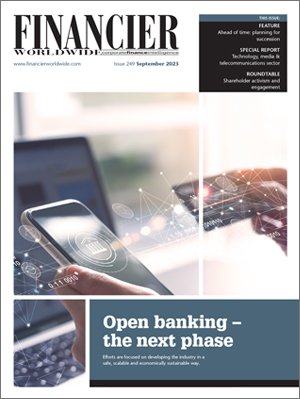Leveraging intellectual property and other intangible assets as collateral
September 2023 | SPECIAL REPORT: TECHNOLOGY, MEDIA & TELECOMMUNICATIONS SECTOR
Financier Worldwide Magazine
With current market forces constraining capital markets and other financing sources, some companies are looking for novel ways to avoid a liquidity crunch, especially if they are facing maturing credit facilities that need to be paid down in the near term or are otherwise experiencing adverse business conditions that require an injection of funds.
An increasing market phenomenon is the leveraging of intellectual property (IP) and other intangible assets as collateral in asset-backed financings, secured notes offerings and other securitisations (herein called IP financing transactions). Given the increasing importance of IP as an asset class to many companies, the use of intangible assets as collateral in this way (particularly if they are foundational to a company’s business) has become attractive to many investors and lenders.
While the use of certain IP financing transactions, such as royalty securitisations deployed in the music and pharmaceutical industries, have historically found favour in the marketplace, IP financing transactions are now being utilised in a wide variety of other industries. Notably, there have been some recent high-profile IP financing transactions involving airlines, consumer product companies, retailers, and software and other technology companies.
The intangible assets used to secure these IP financing transactions are equally varied, with companies leveraging not only traditional registered IP, namely patents, trademarks and copyrights, but also unregistered IP such as proprietary technology, software, trade secrets and databases.
Unlike tangible assets, intangible assets are non-rivalrous and highly divisible. This allows them to be shared, split, licensed and transferred in ways that are not possible with other forms of collateral. This divisibility facilitates greater flexibility and creativity when structuring an IP financing transaction and creates opportunities for companies to unlock value from an unconventional or underutilised source.
The balance that must be struck in any IP financing transaction is preserving sufficient flexibility for the company looking to obtain financing to be able to continue exploiting the intangible assets (which are often a key value driver for its business) while providing the secured parties with adequate assurances that their collateral interest and the value of the intangible assets will be protected up to, and importantly after, any default by the company.
Clearly, IP financing transactions vary in complexity, from traditional secured asset-backed loans to highly bespoke structures such as those deployed by US airlines during the height of the coronavirus (COVID-19) pandemic, which leveraged their customer loyalty programmes to raise much needed funds to help them confront an industry-wide liquidity crisis as air travel grinded to a halt.
As IP financing transactions continue to grow in complexity, parties often seek to establish a ‘mutually assured destruction’ scenario to ensure that all parties to the transaction will act rationally and not seek to circumvent the structure. This tension can be created in a variety of ways given the malleable nature of intangible assets.
One emerging paradigm involves a structure where the company pledging its rights to intangible assets transfers those assets into one or more special purpose vehicles (SPVs), whose shares are also pledged as collateral. These SPVs serve as the grantors of the security interest and licence the intangible assets back to the company on an exclusive basis.
By virtue of the exclusive licence back, the company is kept in largely the same position and continues to have the ability to exploit the pledged intangible assets for the benefit of its business. Meanwhile, depositing the intangible assets in the SPVs provides the secured parties with an enhanced ability to protect and foreclose on the collateral in an event of default, especially if the SPVs, through their respective jurisdictions of incorporation and organisational documents, are designed with bankruptcy remoteness features.
Alternatively, where an SPV-type structure is not feasible, whether due to administrative burden, cost, tax concerns or otherwise, the company seeking to obtain financing can deploy a leaner form of deal technology where the key design feature of the collateral package is an exclusive licence granted directly to the collateral agent under the company’s valuable IP assets.
The financing being provided by the secured parties to the company in this structure may serve as consideration for the licence grant, since the exclusive licence significantly enhances their protections against the company. The collateral agent in turn sublicenses the IP back to the company (with appropriate field and territory limitations), and any default by the company could give rise to a termination by the secured parties of the licence back to the company and the company’s loss of its freedom to operate its business. Additionally, a fee may be payable by the company under this licence, which may be sized to cover debt service under the financing.
The exclusive licence to the collateral agent provides the secured parties with valuable rights that survive bankruptcy, much like the bankruptcy remoteness in the SPV structure. This is because most forms of intellectual property licences are afforded the protection of section 365(n) of the US Bankruptcy Code notwithstanding the executory nature of those contracts. The fact that the collateral agent can make an election to retain its exclusive rights under the licence provides the secured parties with considerable leverage if the licence was ever sought to be rejected by the trustee or debtor-in-possession in a bankruptcy scenario.
The bottom line is that each of these structures creates the requisite tension to keep the parties on their best behaviour and forces them to respect the structure. The company looking to obtain financing cannot conduct its business without the ability to use the pledged rights in those intangible assets, meaning it will be highly incentivised to avoid a default scenario that could result in a catastrophic loss of IP rights that may be foundational to its business.
Meanwhile, seeking to strip the company of its ability to exploit the pledged rights may not be in the secured parties’ interest. In many cases, the pledged intangible assets are inextricably tied to the company’s business and severing those assets from the business to which they relate may result in a loss of value.
Designing these IP financing transactions requires a deep understanding of the intersection of IP and bankruptcy law. The successful implementation of these structures only works if the dominoes all fall in the manner the parties to the transaction intend. Beyond the mechanics of perfecting a secured party’s interest in the intangible assets, among other things, the parties need to contend with certain bankruptcy considerations, including in the US bankruptcy context: (i) the automatic stay that is triggered when a debtor files a Chapter 11 bankruptcy petition; (ii) the potential unenforceability of certain ‘ipso facto’ clauses; (iii) the treatment of executory contracts and relatedly the ability of the trustee or debtor-in-possession to ‘assume or assign’ or ‘reject’ such contracts; and (iv) the unique treatment of certain forms of IP licences.
There are design features that attempt to overcome, or at least mitigate, these obstacles to ensure that the secured parties are not frustrated in their efforts to exercise their remedies. For example, in order to address the automatic stay and a challenge that any termination based on a bankruptcy trigger is ipso facto, the exclusive licence-back to the company in the SPV‑type structure described above might be executed as a sublicence under a master licence agreement between two bankruptcy-remote entities (which will not be subject to the automatic stay if the bankruptcy remoteness holds up as designed).
Using this structure, the secured parties may be able to cause the SPV that owns the IP to terminate the master licence agreement in the event of the company’s bankruptcy, severing the chain used to sublicence the IP to the company.
It is also important that special attention be given to what, if any, valuable intangible assets are already encumbered, including by any existing liens or under any intercompany licence agreements. In an IP financing transaction, secured parties will typically be focused on ensuring these intangible assets have real value, particularly where the guarantors of the facility are the licensees under the intercompany agreements and do not actually own the relevant IP property.
Moreover, these intercompany arrangements may form part of a company’s meticulous tax planning, so transferring ownership of the intangible assets to which the intercompany agreements relate may be undesirable and result in adverse tax consequences. Working with the company’s tax advisers to understand what can be done to not disrupt that tax planning provides an opportunity to tailor a solution that mitigates this exposure.
Ultimately, designing IP financing transactions, with all of their complexity, is never a ‘one size fits all’ approach. However, if structured thoughtfully, the deal architecture will result in incentivising all parties to continue to respect the structure when default, bankruptcy or other disruption arises. While careful structuring of deal mechanics is necessary to make these arrangements function, leveraging intangible assets as collateral has the potential for significant upside for all parties to the transaction.
Understanding how to balance these objectives and make these structures work requires each of the finance, restructuring, capital markets, tax and IP teams on the legal side, together with the company and the financial advisers to the transaction, to all work together collaboratively to achieve this outcome.
Frank J. Azzopardi is a group head and partner, and Christopher Woller and Samantha Lefland are counsels, at Davis Polk & Wardwell LLP. Mr Azzopardi can be contacted on +1 (212) 450 6277 or by email: frank.azzopardi@davispolk.com. Mr Woller can be contacted on +1 (212) 450 3428 or by email: christopher.woller@davispolk.com. Ms Lefland can be contacted on +1 (212) 450 4807 or by email: samantha.lefland@davispolk.com.
© Financier Worldwide
BY
Frank J. Azzopardi, Christopher Woller and Samantha Lefland
Davis Polk & Wardwell LLP


